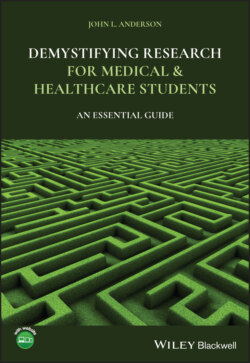Читать книгу Demystifying Research for Medical and Healthcare Students - John L. Anderson - Страница 40
Example 2: My Own Experiment
ОглавлениеI have always been very impressed by Martin Seligman's work and was eager to do my own research on helplessness. So, when I was at the University of Hong Kong in the 1980s, I informed my staff in the Behavioural Sciences Unit in the Faculty of Medicine of my interests. Within a month, half of them had started doing their own work to replicate Seligman and Hiroto's work! My interests were in people's lifelong exposures to helplessness and how these might contribute to helpless characteristics – with the possible implications for survival from cardiovascular diseases and cancers. So, I set out on my quest. I was on ‘long leave’ in London. I had the necessary equipment built – a computerised control box, a set of headphones, and a four‐button board. I made announcements to medical students and asked for volunteers for my pilot study. I vividly remember my first two subjects.
The first was in the control group – no matter what buttons he pressed, or in what order, or how many times, the noise could not be turned off and the red light would come on to signify failure. I remember him on the last of the 20 trials; he was bashing away at the buttons, frantically trying to find the correct sequence. Afterwards, I interviewed him about his life history of feeling in control or helpless. He was what you could call a ‘straight A student’. He had five As or A*s in his A levels. He had never failed an exam in his life. He could never recall or imagine a situation in which he would not succeed. He said to me, ‘Gosh, John, that was a really interesting trial. I know I didn't get it right in the time, but, I reckon that, with a few more goes, I could have got it right!’ I de‐briefed him about the experiment.
The second subject was in the experimental group. By pressing any button four times he could stop the noise immediately. He learned very quickly how he could stop the noise. I remember him on the last of the 20 trials; he looked fed up. As soon as the noise started be quickly pushed a button four times and the noise stopped. Afterwards, I interviewed him about his life history of feeling in control or helpless. He was also what you could call a ‘straight A student’. He had five As or A*s in his A levels. He had never failed an exam in his life. He could never recall or imagine a situation in which he would not succeed. He said to me, ‘I'm sorry, John, that was a real disappointment. I know that I could stop the noise by pushing a button four time. But it can't be as simple as that, so I don't feel that I really got it right – I didn't understand it!’ I de‐briefed him about the experiment.
This confirmed to me the importance of checking with experimental subjects what they think is going on in the experiment. The first subject felt that he was in control – even though he was in the ‘helpless’ group. The second subject thought he was helpless – even though he was in the ‘control’ group! The difference between them was the sense they made of the trial – how they attributed their part in the trial. Interesting, isn't it? But before I could complete my study, two things happened: (i) my equipment broke down and could not be repaired; and, more disappointingly to me, (ii) Martin Seligman and Judy Garber published their book Human Helplessness: Theory and Applications, in which they expounded in great detail an attributional analysis of learned helplessness – just the sort of thing I believed I had discovered!
